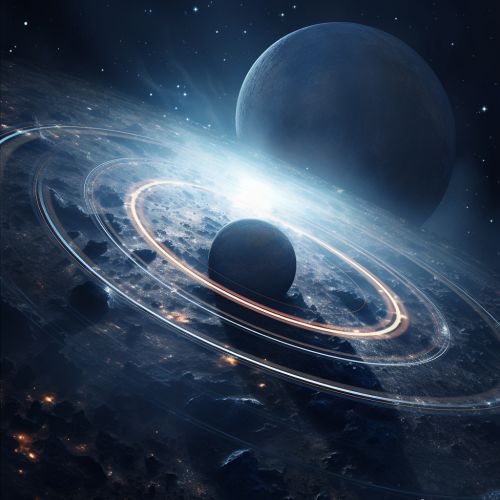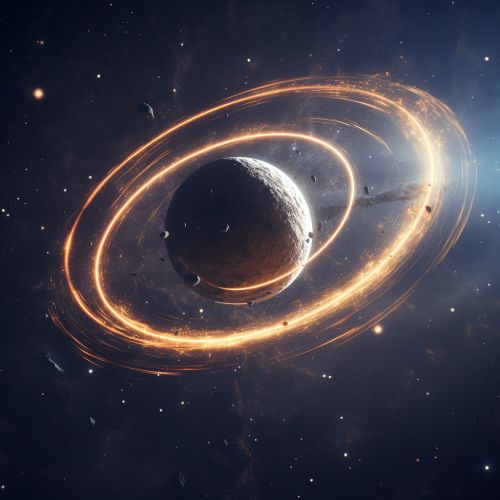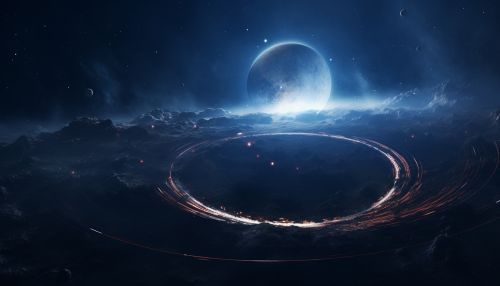Dynamics of Planetary Rings
Introduction
Planetary rings are a fascinating feature of our solar system. They are composed of numerous small particles, ranging in size from micrometers to meters, that orbit around a planet. The most well-known and visually impressive planetary rings are those of Saturn, but rings also exist around other planets including Jupiter, Uranus, and Neptune. The study of these rings and their dynamics is a complex field, involving the application of various branches of physics including celestial mechanics, fluid dynamics, and plasma physics.


Formation and Composition
Planetary rings are believed to have formed from the remnants of moons, asteroids, or comets that were shattered by the gravitational forces of their parent planet. These remnants then spread out in a disc-like formation around the planet, creating a ring system. The composition of these rings can vary, but they are primarily made up of ice particles, with the remainder consisting of dust and rocky material.
Dynamics of Planetary Rings
The dynamics of planetary rings are governed by a combination of gravitational, collisional, and electromagnetic forces. The gravitational forces are primarily due to the planet around which the ring orbits, but can also be influenced by nearby moons or other ring particles. Collisional forces come into play as the particles within the ring collide with each other, causing them to change direction and speed. Electromagnetic forces can also affect the motion of the ring particles, particularly if they are charged and the planet has a magnetic field.
Gravitational Dynamics
The gravitational dynamics of planetary rings are primarily governed by the gravity of the planet around which they orbit. This gravity pulls the ring particles towards the planet, keeping them in orbit. However, the gravitational forces are not uniform across the ring. The inner parts of the ring are closer to the planet and thus experience a stronger gravitational pull than the outer parts. This differential in gravitational force can lead to the formation of ring structures such as gaps and waves.


Collisional Dynamics
The collisional dynamics of planetary rings involve the interactions between the individual particles within the ring. These particles are constantly colliding with each other, causing them to change direction and speed. The frequency and intensity of these collisions can affect the overall structure and appearance of the ring. For example, frequent collisions can lead to the formation of a dense, narrow ring, while infrequent collisions can result in a more diffuse, broad ring.
Electromagnetic Dynamics
The electromagnetic dynamics of planetary rings come into play if the ring particles are charged and the planet has a magnetic field. The charged particles will be affected by the magnetic field, causing them to move in a spiral path around the magnetic field lines. This can lead to the formation of unique ring structures, such as the spokes seen in Saturn's rings.
Notable Planetary Rings
Saturn's Rings
Saturn's rings are the most famous and visually impressive of all the planetary rings. They are composed primarily of ice particles, with a smaller amount of rocky material. The rings are divided into several distinct sections, named alphabetically in the order they were discovered. The most prominent of these are the A, B, and C rings, which are separated by gaps known as the Cassini Division and the Encke Gap.
Jupiter's Rings
Jupiter's rings are much fainter and less extensive than Saturn's. They are composed primarily of dust particles, believed to be kicked up by impacts on the planet's small inner moons. The main ring is thin and narrow, while the outer gossamer rings are more diffuse and broad.
Uranus' Rings
Uranus' rings are composed primarily of dark, rocky material. They are narrow and dense, with sharp edges. The rings are believed to be relatively young, having formed within the last few hundred million years.
Neptune's Rings
Neptune's rings are faint and difficult to observe. They are composed primarily of dust particles, with a small amount of ice. The rings are narrow and clumpy, with arcs of denser material.
Future Research
The study of planetary rings continues to be a vibrant field of research, with many unanswered questions remaining. Future missions to the outer planets may provide further insights into the formation, composition, and dynamics of these fascinating structures.
